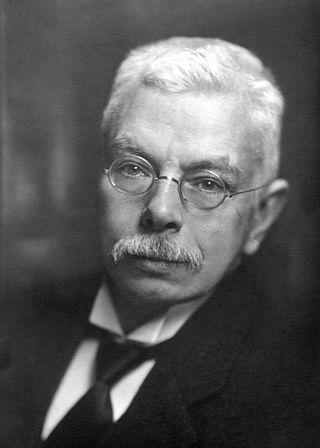Top Qs
Timeline
Chat
Perspective
Pieter Zeeman
Dutch experimental physicist (1865–1943) From Wikipedia, the free encyclopedia
Remove ads
Pieter Zeeman (/ˈzeɪmɑːn/ ZAY-mahn;[2] Dutch: [ˈzeːmɑn] ⓘ; 25 May 1865 – 9 October 1943) was a Dutch experimental physicist who shared the 1902 Nobel Prize in Physics with Hendrik Lorentz for their discovery and theoretical explanation of the Zeeman effect.[3][4][5][6][7]
Remove ads
Education
Summarize
Perspective
Pieter Zeeman was born on 25 May 1865 in Zonnemaire, Netherlands, the son of the Reverend Catharinus Forandinus Zeeman, a minister of the Dutch Reformed Church, and Willemina Worst.
Zeeman became interested in physics at an early age. In 1883, the aurora borealis happened to be visible in the Netherlands; Zeeman, then a student at the high school in Zierikzee, made a drawing and description of the phenomenon and submitted it to Nature, where it was published. The editor praised "the careful observations of Professor Zeeman from his observatory in Zonnemaire."
After finishing high school in 1883, Zeeman went to Delft for supplementary education in classical languages, then a requirement for admission to university. He stayed at the home of Dr J. W. Lely, co-principal of the gymnasium and brother of Cornelis Lely, who was responsible for the concept and realization of the Zuiderzee Works. While in Delft, he first met Heike Kamerlingh Onnes, who would become his doctoral advisor.

After passing the qualification exams in 1885, Zeeman entered Leiden University to study physics under Kamerlingh Onnes and Hendrik Lorentz. In 1890, he became Lorentz's assistant, which allowed him to participate in a research programme on the Kerr effect. In 1893, he submitted his doctoral thesis on the Kerr effect,[8] the reflection of polarized light on a magnetized surface. After receiving his Ph.D., he went for half a year to Friedrich Kohlrausch's institute at the University of Strassburg. In 1895, he returned to Leiden to become a Privatdozent in mathematics and physics.[9][10][11][12]
Remove ads
Zeeman effect
Summarize
Perspective

In 1896, shortly before moving from Leiden to Amsterdam,[14] Zeeman measured the splitting of spectral lines by a strong magnetic field, a discovery now known as the Zeeman effect. This research involved an investigation of the effect of magnetic fields on a light source. He discovered that a spectral line is split into several components in the presence of a magnetic field. Hendrik Lorentz first heard about Zeeman's observations on Saturday 31 October 1896 at the meeting of the Royal Netherlands Academy of Arts and Sciences, where these results were communicated by Heike Kamerlingh Onnes.[15] The next Monday, Lorentz called Zeeman into his office and presented him with an explanation of his observations, based on Lorentz's theory of electromagnetic radiation. In 1902, Zeeman and Lorentz were jointly awarded the Nobel Prize in Physics for their respective experimental and theoretical work on the Zeeman effect.[16]
The importance of Zeeman's discovery soon became apparent; it confirmed Lorentz's prediction about the polarization of light emitted in the presence of a magnetic field. Thanks to Zeeman's work, it became clear that the oscillating particles, according to Lorentz were the source of light emission, were negatively charged, and were a thousandfold lighter than the hydrogen atom. This conclusion was reached well before J. J. Thomson's discovery of the electron. The Zeeman effect thus became an important tool for elucidating the structure of the atom.
Remove ads
Career in Amsterdam
Summarize
Perspective


Shortly after his discovery, Zeeman was offered a position as a lecturer at the University of Amsterdam, where he started to work in the autumn of 1896.[14] This was followed by his promotion to Professor of Physics in 1900. In 1908, he succeeded Johannes van der Waals as full professor and Director of the Physics Institute. He retired as a professor in 1935.
In 1918, Zeeman published "Some experiments on gravitation: The ratio of mass to weight for crystals and radioactive substances" in the Proceedings of the Koninklijke Nederlandse Akademie van Wetenschappen, experimentally confirming the equivalence principle with regard to gravitational and inertial mass.
A new laboratory built in Amsterdam in 1923 was renamed the Zeeman Laboratory in 1940. This new facility allowed Zeeman to pursue a refined investigation of the Zeeman effect. For the remainder of his career he remained interested in research in magneto-optic effects. He also investigated the propagation of light in moving media. This subject became the focus of a renewed interest because of special relativity, and enjoyed a keen interest from Lorentz and Albert Einstein. Later in his career, he became interested in mass spectrometry.
Personal life and death
In 1895, Zeeman married Johanna Elisabeth Lebret (1873–1962), with whom he had three daughters and one son.[12]
Zeeman died on 9 October 1943 in Amsterdam at the age of 78, and was buried in Haarlem.
Recognition
Memberships
Awards
Remove ads
See also
References
External links
Wikiwand - on
Seamless Wikipedia browsing. On steroids.
Remove ads

